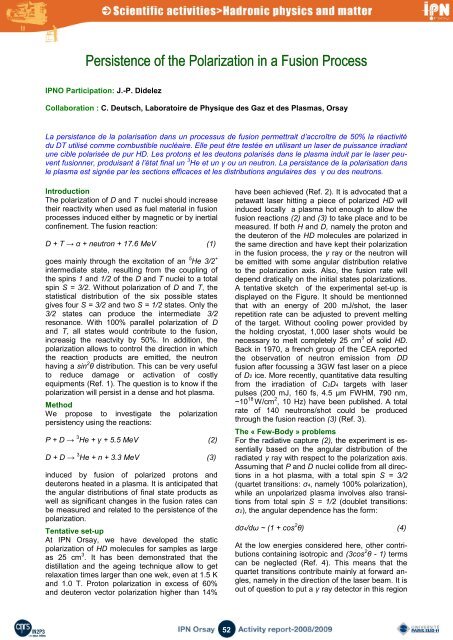exotic nuclei structure and reaction noyaux exotiques ... - IPN - IN2P3
exotic nuclei structure and reaction noyaux exotiques ... - IPN - IN2P3
exotic nuclei structure and reaction noyaux exotiques ... - IPN - IN2P3
You also want an ePaper? Increase the reach of your titles
YUMPU automatically turns print PDFs into web optimized ePapers that Google loves.
Persistence of the Polarization in a Fusion Process<br />
<strong>IPN</strong>O Participation: J.-P. Didelez<br />
Collaboration : C. Deutsch, Laboratoire de Physique des Gaz et des Plasmas, Orsay<br />
La persistance de la polarisation dans un processus de fusion permettrait d’accroître de 50% la réactivité<br />
du DT utilisé comme combustible nucléaire. Elle peut être testée en utilisant un laser de puissance irradiant<br />
une cible polarisée de pur HD. Les protons et les deutons polarisés dans le plasma induit par le laser peuvent<br />
fusionner, produisant à l’état final un 3 He et un γ ou un neutron. La persistance de la polarisation dans<br />
le plasma est signée par les sections efficaces et les distributions angulaires des γ ou des neutrons.<br />
Introduction<br />
The polarization of D <strong>and</strong> T <strong>nuclei</strong> should increase<br />
their reactivity when used as fuel material in fusion<br />
processes induced either by magnetic or by inertial<br />
confinement. The fusion <strong>reaction</strong>:<br />
D + T → α + neutron + 17.6 MeV (1)<br />
goes mainly through the excitation of an 5 He 3/2 +<br />
intermediate state, resulting from the coupling of<br />
the spins 1 <strong>and</strong> 1/2 of the D <strong>and</strong> T <strong>nuclei</strong> to a total<br />
spin S = 3/2. Without polarization of D <strong>and</strong> T, the<br />
statistical distribution of the six possible states<br />
gives four S = 3/2 <strong>and</strong> two S = 1/2 states. Only the<br />
3/2 states can produce the intermediate 3/2<br />
resonance. With 100% parallel polarization of D<br />
<strong>and</strong> T, all states would contribute to the fusion,<br />
increasig the reactvity by 50%. In addition, the<br />
polarization allows to control the direction in which<br />
the <strong>reaction</strong> products are emitted, the neutron<br />
having a sin 2 θ distribution. This can be very useful<br />
to reduce damage or activation of costly<br />
equipments (Ref. 1). The question is to know if the<br />
polarization will persist in a dense <strong>and</strong> hot plasma.<br />
Method<br />
We propose to investigate the polarization<br />
persistency using the <strong>reaction</strong>s:<br />
P + D → 3 He + γ + 5.5 MeV (2)<br />
D + D → 3 He + n + 3.3 MeV (3)<br />
induced by fusion of polarized protons <strong>and</strong><br />
deuterons heated in a plasma. It is anticipated that<br />
the angular distributions of final state products as<br />
well as significant changes in the fusion rates can<br />
be measured <strong>and</strong> related to the persistence of the<br />
polarization.<br />
Tentative set-up<br />
At <strong>IPN</strong> Orsay, we have developed the static<br />
polarization of HD molecules for samples as large<br />
as 25 cm 3 . It has been demonstrated that the<br />
distillation <strong>and</strong> the ageing technique allow to get<br />
relaxation times larger than one wek, even at 1.5 K<br />
<strong>and</strong> 1.0 T. Proton polarization in excess of 60%<br />
<strong>and</strong> deuteron vector polarization higher than 14%<br />
have been achieved (Ref. 2). It is advocated that a<br />
petawatt laser hitting a piece of polarized HD will<br />
induced locally a plasma hot enough to allow the<br />
fusion <strong>reaction</strong>s (2) <strong>and</strong> (3) to take place <strong>and</strong> to be<br />
measured. If both H <strong>and</strong> D, namely the proton <strong>and</strong><br />
the deuteron of the HD molecules are polarized in<br />
the same direction <strong>and</strong> have kept their polarization<br />
in the fusion process, the γ ray or the neutron will<br />
be emitted with some angular distribution relative<br />
to the polarization axis. Also, the fusion rate will<br />
depend dratically on the initial states polarizations.<br />
A tentative sketch of the experimental set-up is<br />
displayed on the Figure. It should be mentionned<br />
that with an energy of 200 mJ/shot, the laser<br />
repetition rate can be adjusted to prevent melting<br />
of the target. Without cooling power provided by<br />
the holding cryostat, 1,000 laser shots would be<br />
necessary to melt completely 25 cm 3 of solid HD.<br />
Back in 1970, a french group of the CEA reported<br />
the observation of neutron emission from DD<br />
fusion after focussing a 3GW fast laser on a piece<br />
of D2 ice. More recently, quantitative data resulting<br />
from the irradiation of C2D4 targets with laser<br />
pulses (200 mJ, 160 fs, 4.5 μm FWHM, 790 nm,<br />
~10 18 W/cm 2 , 10 Hz) have been published. A total<br />
rate of 140 neutrons/shot could be produced<br />
through the fusion <strong>reaction</strong> (3) (Ref. 3).<br />
The « Few-Body » problems<br />
For the radiative capture (2), the experiment is essentially<br />
based on the angular distribution of the<br />
radiated γ ray with respect to the polarization axis.<br />
Assuming that P <strong>and</strong> D <strong>nuclei</strong> collide from all directions<br />
in a hot plasma, with a total spin S = 3/2<br />
(quartet transitions: σ4, namely 100% polarization),<br />
while an unpolarized plasma involves also transitions<br />
from total spin S = 1/2 (doublet transitions:<br />
σ2), the angular dependence has the form:<br />
dσ4/dω ~ (1 + cos 2 θ) (4)<br />
At the low energies considered here, other contributions<br />
containing isotropic <strong>and</strong> (3cos 2 θ - 1) terms<br />
can be neglected (Ref. 4). This means that the<br />
quartet transitions contribute mainly at forward angles,<br />
namely in the direction of the laser beam. It is<br />
out of question to put a γ ray detector in this region<br />
52

















